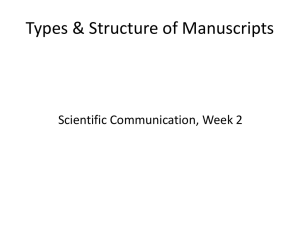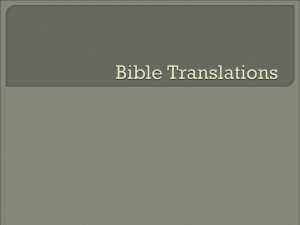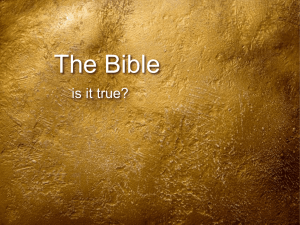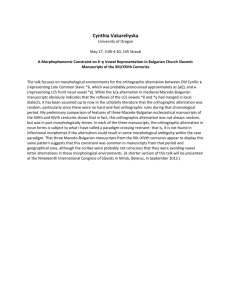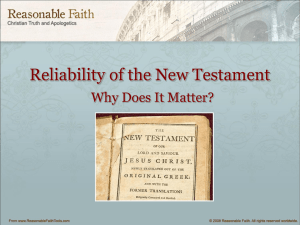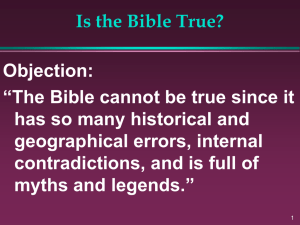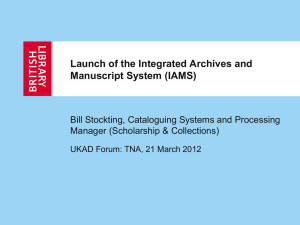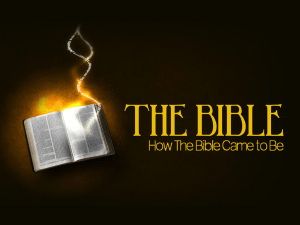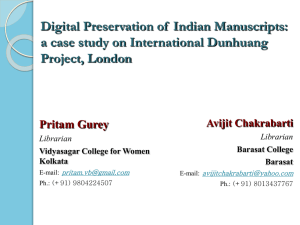clicking here - First Presbyterian Church
advertisement
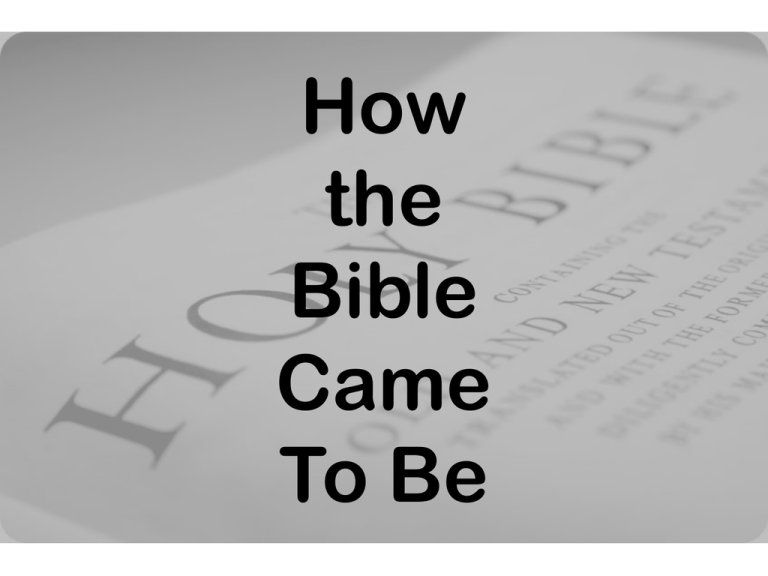
How the Bible Came To Be Development of the Canon Canon Hebrew word meaning “reed.” Reeds were cut and used as measuring sticks. Canon means a rule or standard by which other books, beliefs and practices are compared and evaluated. The 10 Commandments were the first canon of Hebrew Scriptures Their placement in the Ark of the Covenant showed their sacred status After the birth of the Church, the primary authority was Jesus’ teachings The apostles shared Jesus’ words with the new Christians. The first written documents of the early church were probably collections of Jesus’ teachings. These collections would later become the sources that were used in writing the four Gospels. The Secondary Authorities Because the apostles (original disciples) had been with Jesus and witnessed his ministry, their words became authoritative, too. As the apostles died, their living witness was replaced by written documents. Although not one of the twelve original disciples, Paul gained the title of “Apostle” after his conversion and call to bring the Gospel to the Gentiles. Paul’s letters became authoritative because of his status as an apostle: Romans 1 & 2 Corinthians Galatians Ephesians Philippians Colossians 1 & 2 Thessalonians 1 & 2 Timothy Titus Philemon In AD 150, an antisemitic heretic named Marcion published a list of books he considered to be authoritative and instructive. Muratorian Canon Marcion’s list prompted the other Church Fathers to publish a more generally accepted list. The Muratorian Canon was published between 170-200. It contained: • The four Gospels • Acts • Paul’s thirteen letters • Jude • Revelation • 1 John • 2 John or 3 John, or both By the end of the Second Century, the NT was nearly complete. The original versions of the twenty-seven books of the New Testament probably disappeared within a few decades of their composition. We only have handwritten copies (called manuscripts, or MSS) of these books. Because they are handwritten copies, no two manuscripts are exactly alike. How many manuscripts? Papyri 124 Majuscules Minuscules 318 2895 Lectionaries Total 2436 5773 The oldest manuscripts date to about AD 200 and include large portions of the gospels and Paul’s letters. How to Get to the Original? We cannot be absolutely certain of the exact wording of the original documents, but with such a wealth of manuscripts, experts use two criteria: We cannot be absolutely certain of the exact wording of the original documents, but with such a wealth of manuscripts, experts use two criteria: External Evidence We cannot be absolutely certain of the exact wording of the original documents, but with such a wealth of manuscripts, experts use two criteria: External Evidence Internal Evidence External Evidence Compares the variety of witnesses – all of the manuscripts, versions and references in early church writings. Internal Evidence Looks at the variations in wording among the manuscripts, including differences in writing style, vocabulary and grammar. Example: Mark 16:9-20 1. Grammar, vocabulary and writing style are different from the rest of the book 2. Earliest manuscripts do not include these verses Conclusion: these verses were added later; were not part of the original book. Finally, one combination of all of those manuscripts is developed with the wording experts believe to be closest to the original. It is from that final, authoritative document that modern English translations are made. Why all those translations?! Two approaches to translation: 1. Formal (word-for-word) 2. Functional (thought-forthought). Translators try to balance being as true to the word-for-word translation while still getting the meaning of the original. Translators try to balance being as true to the word-for-word translation while still getting the meaning of the original. However, nearly all translations tend toward one or the other. Where does your translation fall on the continuum? Two very popular versions of the Bible, The Living Bible and The Message are not considered to be “translations,” but rather “paraphrases,” where the author puts the text into his/her own words. Little if any word-for-word faithfulness. The Living Bible is a paraphrase of the King James Version; The Message is a paraphrase based on the original Hebrew and Greek languages. W H A T K I N G A B O U T J A M E S ? In 1604, King James I authorized a new translation of the whole Bible for use in the churches of England. The leading university scholars in England produced the Authorized Version of 1611, commonly known as the King James Version. It has been revised numerous times since. The revision of 1769 is the one most prominent today. New translations have been produced in the last 60 years for two reasons: 1. The translators of the KJV used only about a half dozen very late Greek manuscripts to translate the NT. Since that time many older MSS have been discovered which more likely reflect the original text. 2. The KJV’s use of archaic English words and phrases like “aforetime,” “must needs,” “howbeit,” “peradventure,” make the text harder to understand, defeating the original purpose of providing a Bible that was easy for common people to understand. Many of today’s versions are more accurate in their translations, and easier to understand. Many of today’s versions are more accurate in their translations, and easier to understand. One thing we can all be sure of… Jesus did not speak the King’s English, nor did the original authors write it! The End.

